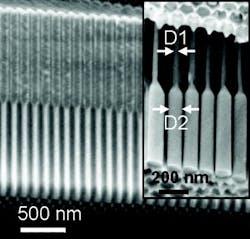Dual-diameter geometry boosts nanopillar light-collector efficiency
Berkeley, CA--Optically active semiconductor nanopillar arrays now absorb sunlight better than ever, thanks to research carried out at Lawrence Berkeley National Laboratory and the University of California at Berkeley.1
Nanopillar tune-up
"By tuning the shape and geometry of highly ordered nanopillar arrays of germanium or cadmium sulfide, we have been able to drastically enhance the optical absorption properties of our nanopillars," says Ali Javey, one of the researchers.
Javey and his group were the first to demonstrate a technique by which cadmium sulfide nanopillars can be mass-produced in large-scale flexible modules. In this latest work, they were able to produce nanopillars that absorb light as well or even better than commercial thin-film solar cells, using far less semiconductor material and without the need for antireflective coatings.
"To enhance the broadband optical absorption efficiency of our nanopillars, we used a novel dual-diameter structure that features a small (60 nm) diameter tip with minimal reflectance to allow more light in, and a large (130 nm) diameter base for maximal absorption to enable more light to be converted into electricity," Javey says. "This dual-diameter structure absorbed 99% of incident visible light, compared to the 85% absorption by our earlier nanopillars, which had the same diameter along their entire length."
Work has shown that 3D arrays of semiconductor nanopillars with well-defined diameter, length and pitch excel at trapping light while using less than half the semiconductor material required for thin-film solar cells made of compound semiconductors, such as cadmium telluride, and about 1% of the material used in solar cells made from bulk silicon. But until the work of Javey and his research group, fabricating such nanopillars was a complex and cumbersome procedure.
Alumina foil sure comes in handy
Javey and his colleagues fashioned their dual-diameter nanopillars from molds they made in 2.5-µm-thick alumina foil (see figure). A two-step anodization process was used to create an array of 1-µm-deep pores in the mold with dual diameters. Gold particles were then deposited into the pores to catalyze the growth of the semiconductor nanopillars.
The germanium nanopillars can be tuned to absorb infrared photons for highly sensitive detectors, and the cadmium sulfide/telluride nanopillars are ideal for solar cells. The fabrication technique is highly generic, Javey says; it could be used with numerous other semiconductor materials as well for specific applications. Recently, he and his group demonstrated that the cross-sectional portion of the nanopillar arrays can also be tuned to assume specific shapes--square, rectangle or circle--by changing the shape of the template.
REFERENCE:
1. Zhiyong Fan et al., Nano Letters, 10 (10), p. 3823 (2010).
Subscribe now to Laser Focus World magazine; it’s free!
About the Author
John Wallace
Senior Technical Editor (1998-2022)
John Wallace was with Laser Focus World for nearly 25 years, retiring in late June 2022. He obtained a bachelor's degree in mechanical engineering and physics at Rutgers University and a master's in optical engineering at the University of Rochester. Before becoming an editor, John worked as an engineer at RCA, Exxon, Eastman Kodak, and GCA Corporation.

